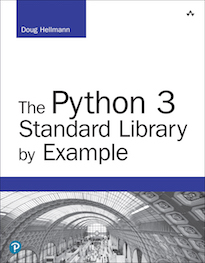Low-level Thread Support¶
sys includes low-level functions for controlling and debugging
thread behavior.
Switch Interval¶
Python 3 uses a global lock to prevent separate threads from corrupting the interpreter state. After a configurable time interval, bytecode execution is paused and the interpreter checks if any signal handlers need to be executed. During the same check, the global interpreter lock (GIL) is also released by the current thread and then reacquired, with other threads given priority over the thread which has just released the lock.
The default switch interval is 5 milliseconds and the current value
can always be retrieved with sys.getswitchinterval(). Changing
the interval with sys.setswitchinterval() may have an impact on
the performance of an application, depending on the nature of the
operations being performed.
import sys
import threading
from queue import Queue
def show_thread(q):
for i in range(5):
for j in range(1000000):
pass
q.put(threading.current_thread().name)
return
def run_threads():
interval = sys.getswitchinterval()
print('interval = {:0.3f}'.format(interval))
q = Queue()
threads = [
threading.Thread(target=show_thread,
name='T{}'.format(i),
args=(q,))
for i in range(3)
]
for t in threads:
t.setDaemon(True)
t.start()
for t in threads:
t.join()
while not q.empty():
print(q.get(), end=' ')
print()
return
for interval in [0.001, 0.1]:
sys.setswitchinterval(interval)
run_threads()
print()
When the switch interval is less than the amount of time a thread takes to run to completion, the interpreter gives another thread control so that it runs for a while. This is illustrated in the first set of output where the interval is set to 1 millisecond.
For longer intervals, the active thread will be able to complete more work before it is forced to release control. This is illustrated by the order of the name values in the queue in the second example using an interval of 10 milliseconds.
$ python3 sys_switchinterval.py
interval = 0.001
T0 T1 T2 T1 T0 T2 T0 T1 T2 T1 T0 T2 T1 T0 T2
interval = 0.100
T0 T0 T0 T0 T0 T1 T1 T1 T1 T1 T2 T2 T2 T2 T2
Many factors other than the switch interval may control the context switching behavior of Python’s threads. For example, when a thread performs I/O it releases the GIL and may therefore allow another thread to take over execution.
Debugging¶
Identifying deadlocks can be one of the most difficult aspects of
working with threads. sys._current_frames() can help by showing
exactly where a thread is stopped.
1 2 3 4 5 6 7 8 9 10 11 12 13 14 15 16 17 18 19 20 21 22 23 24 25 26 27 28 29 30 31 32 33 34 35 36 37 38 39 40 41 42 43 44 | import sys
import threading
import time
io_lock = threading.Lock()
blocker = threading.Lock()
def block(i):
t = threading.current_thread()
with io_lock:
print('{} with ident {} going to sleep'.format(
t.name, t.ident))
if i:
blocker.acquire() # acquired but never released
time.sleep(0.2)
with io_lock:
print(t.name, 'finishing')
return
# Create and start several threads that "block"
threads = [
threading.Thread(target=block, args=(i,))
for i in range(3)
]
for t in threads:
t.setDaemon(True)
t.start()
# Map the threads from their identifier to the thread object
threads_by_ident = dict((t.ident, t) for t in threads)
# Show where each thread is "blocked"
time.sleep(0.01)
with io_lock:
for ident, frame in sys._current_frames().items():
t = threads_by_ident.get(ident)
if not t:
# Main thread
continue
print('{} stopped in {} at line {} of {}'.format(
t.name, frame.f_code.co_name,
frame.f_lineno, frame.f_code.co_filename))
|
The dictionary returned by sys._current_frames() is keyed on the
thread identifier, rather than its name. A little work is needed to
map those identifiers back to the thread object.
Since Thread-1 does not sleep, it finishes before its status is
checked. Since it is no longer active, it does not appear in the
output. Thread-2 acquires the lock blocker, then sleeps for a
short period. Meanwhile Thread-3 tries to acquire blocker but
cannot because Thread-2 already has it.
$ python3 sys_current_frames.py
Thread-1 with ident 123145307557888 going to sleep
Thread-1 finishing
Thread-2 with ident 123145307557888 going to sleep
Thread-3 with ident 123145312813056 going to sleep
Thread-3 stopped in block at line 18 of sys_current_frames.py
Thread-2 stopped in block at line 19 of sys_current_frames.py
See also
threading– Thethreadingmodule includes classes for creating Python threads.Queue– TheQueuemodule provides a thread-safe implementation of a FIFO data structure.- Reworking the GIL – Email from Antoine Pitrou to the python-dev mailing list describing the GIL implementation changes to introduce the switch interval.
 PyMOTW-3
PyMOTW-3